For years now, whenever I drive on Lombard where it goes under 42nd Avenue, I’ll shake my head and mumble angrily to myself. “So disrespectful… Makes me sick they can just drop a bike lane like that… Look how dangerous that is!… Grrrr…” My poor family just rolls their eyes in a “There goes dad again” type of a way.
When Martin Greenough died after being hit from behind while biking in this exact location, I felt a strange combination of sadness, anger, frustration and validation. We’ve reported on this location twice in the past. Once in 2013 and again — amazingly — just one day before his death.
I had never ridden this particular stretch of Lombard, so I felt a need to get out there myself to take a closer look. Here’s what I saw…
I rolled onto Lombard around NE 29th and hung a right (east) toward 42nd. Lombard has a curbside bike lane in this section. Unfortunately a car was parked in it and I was forced into the adjacent lanes where people in cars and large trucks flew by at five times my speed:
Approaching the 33rd Avenue overpass there’s a curbside parking lane in addition to the bike lane. As you can see from the faded paint and gravel, this isn’t a bikeway that the Oregon Department of Transportation takes very seriously:
It’s too bad, because Lombard is wide enough to make a protected bike lane that could connect thousands of people and several neighborhoods and destinations:
As I got closer to 42nd, there was yet another dangerous spot. The exit to 42nd is a very lax angle which allows people to carry a lot of speed into it. And there’s little to no warning about the possible presence of a bike lane user:
Advertisement
Then I arrived at the place where Martin took his last few pedal strokes. The only indication to road users that anything might merit caution was this sign:
That sign does nothing to build confidence for people on bikes and it does nothing to alter the behavior of people in cars. I have raced bikes (off and on) for over 20 years and I’m an extremely confident urban rider; but even I felt it would be irresponsible to my family if I rode in that gap. So I parked my bike and walked.
I noticed that not only do the bike lanes go away, the road itself shifts north a bit. It’s a very dangerous combination:
I noticed that many other people avoid the gap by hopping up the curb and walking or riding behind the guardrail, under the overpass, and then re-join the bike lane on the other side. I could see tire tracks in the dirt and there’s plenty of room to make that maneuver (and plenty of room for ODOT to formalize this path):
Here’s a look at the eastbound lane and the dirt path next to it from above:
As I stood under the bridge my blood really started to boil. How could they?! How could ODOT think it’s OK to throw bicycle riders to the wolves like this?
After taking some measurements of the lanes (for reference and for future stories), I crossed Lombard to check out the westbound direction. It’s pretty much the exact same situation. The bike lane ends and there’s nowhere to ride.
A few things become clear after you spend time at this location. First you realize how deadly this road is: Not just for people on bikes and foot, but for everyone who uses it. Second, it becomes very apparent that ODOT does not respect bicycle users at all on this section of Lombard and/or they simply assume no one on a bike uses it.
Speaking of which, when I left the area and rode up the 42nd Avenue ramp from Lombard (which is the way you’d go to avoid the gap if you were heading east), I suddenly faced this huge clump of blackberry bushes, vines and leaves in my lane. The only way around was to — once again — merge into the adjacent lane where people were traveling in cars at much higher speeds and were given no warning that I might be there.
ODOT needs to fix this gap and clean up their act on Lombard near 42nd. Something needs to happen immediately. This is an open wound for our community and it’s a public safety hazard. I hope ODOT and its Region 1 Director Rian Windsheimer take this seriously. We plan to keep reporting about it until they do.
Next up, we’ll take a look at some of the ways ODOT could make this section of Lombard safer.
— Jonathan Maus, (503) 706-8804 – jonathan@bikeportland.org



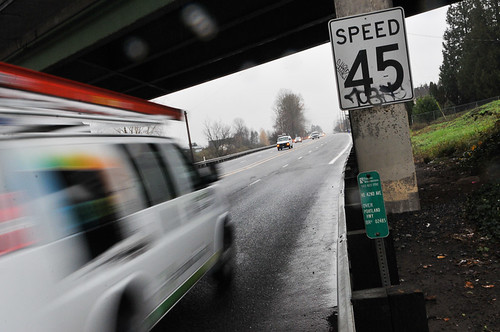
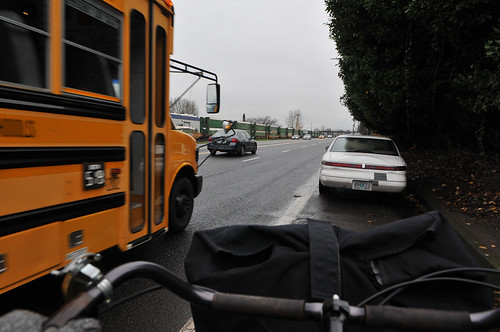
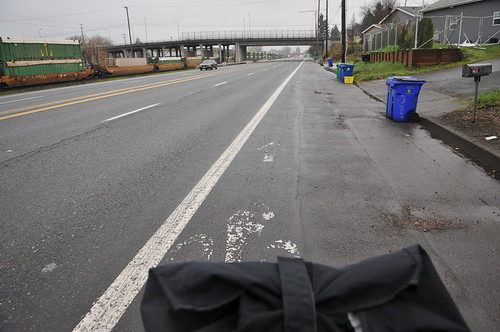
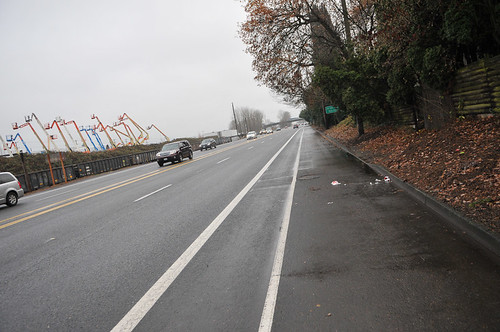
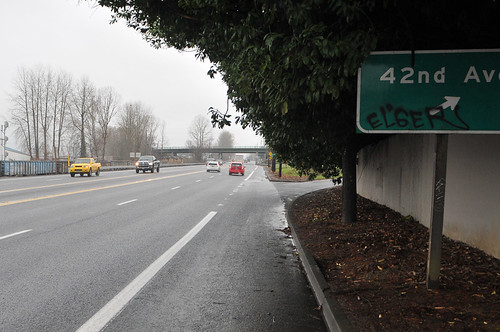
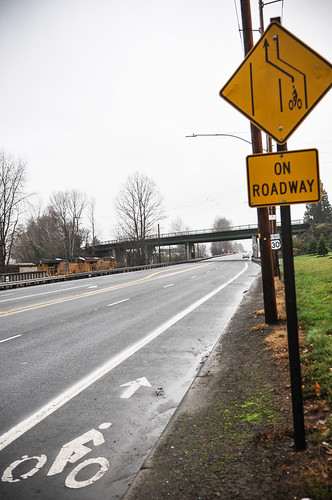
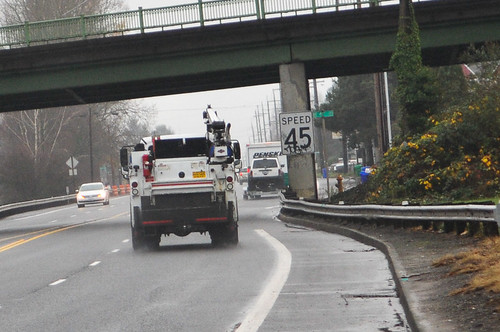
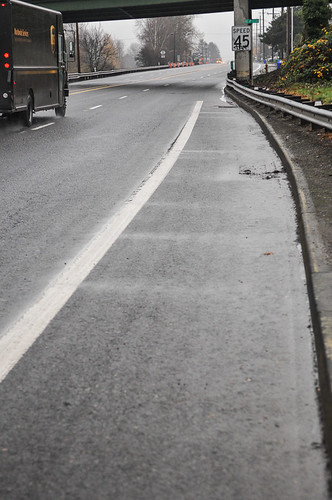
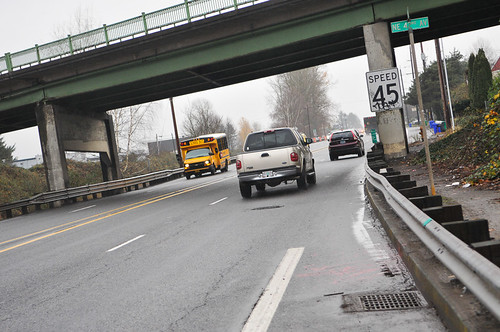
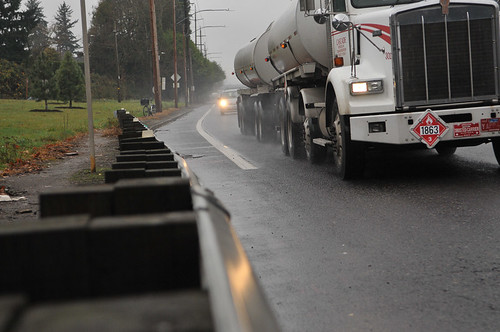
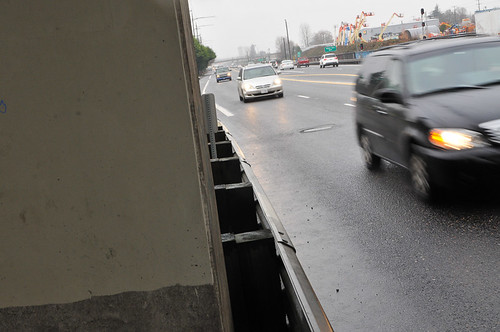
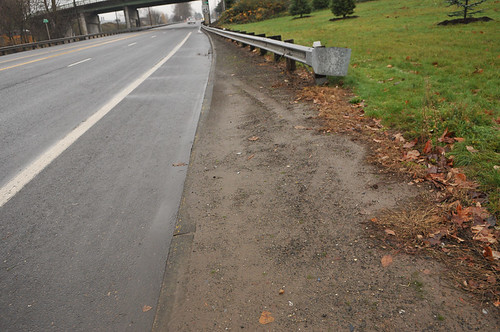
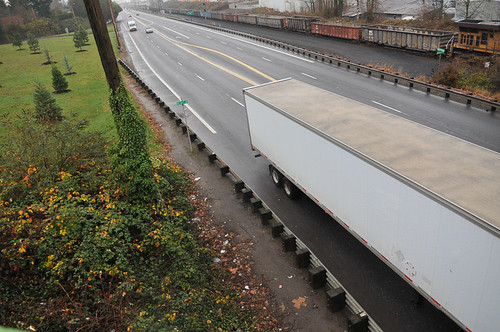
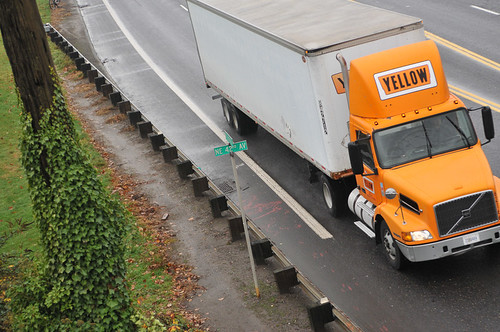
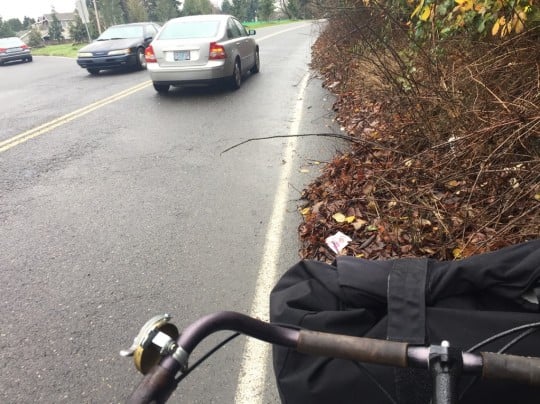
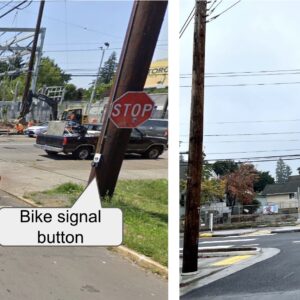
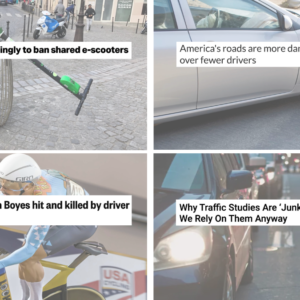
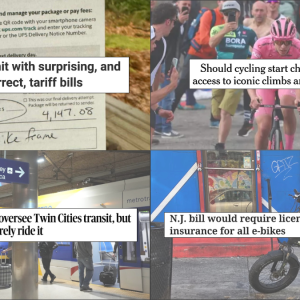
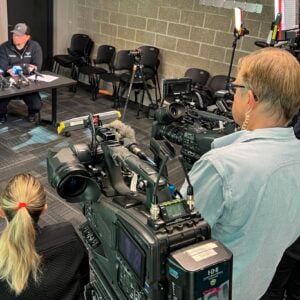
Thanks for reading.
BikePortland has served this community with independent community journalism since 2005. We rely on subscriptions from readers like you to survive. Your financial support is vital in keeping this valuable resource alive and well.
Please subscribe today to strengthen and expand our work.
It should be illegal to install painted bike lanes next to 50 MPH car traffic without physical separation. There should at a minimum be a parallel multi-use path. Designing for the “strong and fearless” will not get us to 25% mode share.
Of course they’ll take this as an excuse to:
() remove 90% of the state’s bicycle lanes
() widen the freight lanes
() stonewall other bicycle infrastructure
() in particular saying that now that the freight lane has been widened it can’t legally be narrowed to reinstall bicycle lanes
() laugh at us when they say “you asked for the bike lanes to be removed!”
What we need are better standards for cycle infrastructure based on adjacent motor traffic speed. The higher the speed, the greater the protection. Too often, painted bike lanes are installed without any regard to how safe they are to use.
Start with: anything over 30 MPH (that’s actual speed, not posted speed) must have either physical protection or devices to lower motor traffic speed to under 30. PBOT does a good job with traffic-calming devices, but we need them city-wide, and unfortunately there is a lack of political will for this.
Seems reasonable, but instead of making this up, why not check how other places do it; you know, the cities and countries some here insist we should stop comparing ourselves to.
That’s exactly my point. The Dutch and Danish already figured this out after 40 years of trial and error. No need to reinvent the wheel. It’s perfectly acceptable to copy Dutch design.
Oh…now you are being a trouble maker….and what did they say….hater?
Seriously.. Stop the sedition.
Huh? What are you saying that adds to the conversation? This is flag-worthy.
“It should be illegal to install painted bike lanes next to 50 MPH car traffic without physical separation. …” adam h
Great idea. Now let’s hear your idea, or that of anyone else that has a reasonable one, for getting the money to build that type bike lane.
Some fifty years ago when Portland and the state, first latched onto the idea of providing bike lanes on its roads, had physical separation been a condition of building bike lanes, residents of the state likely would not have been prepared to provide the cost of building many miles of them.
Painted lanes may have worked 50 years ago, but laws must change and evolve with the times, and it’s clear that painted lanes no longer are cutting it. As far as funding, we could have world-class cycling infrastructure city-wide for the price of one highway interchange. We just need to shift priorities away from car travel and towards cycling and walking.
“…As far as funding, we could have world-class cycling infrastructure city-wide for the price of one highway interchange. We just need to shift priorities away from car travel and towards cycling and walking.” adam
Successfully having priorities shifted in that direction, is a tough call. I think people today generally consider infrastructure supporting growing use of motor vehicles, to be ‘the’ priority. Beginning a program to start retrofitting all of Oregon’s roads and streets to have physical separation that would prevent people riding bikes from being hit in collisions due to nutty people DUI, would be a monumental expense it does not seem to me that residents would support.
Within individual neighborhoods and communities, I feel there’s likely to be a greater willingness to invest in road and street infrastructure that’s better for walking and biking. Because, people are not willing to completely subordinate the livability and functionality of their neighborhood, to unlimited motor vehicle use arising from the demands of population and economic growth.
It will be a great day when schools have all the money they need and the Air Force has to hold a bake sale to buy a bomber.
Here is where I tend to agree with those who favor protected facilities. A high-speed route like this, with few (or widely-spaced) intersections is a perfect place for an off-street path that is wide enough to further separate pedestrian and bicycle traffic.
IMO, the best use for off-street bike paths would be paths that separate bike from pedestrian traffic and serve as “express routes” between neighborhoods or even suburbs/nearby towns. These routes would be treated the same as automotive freeways: wide, well-lit, striped, signed for way-finding, and signalized when (rarely) necessary. They would be designed for speeds from 10 – 25 mph, with passing room and minimal grades. You know, “first class”.
Signs like the one in the photo clearly show that ODOT Knew that this was a problem area. When we see these, we should pause, and think, how could this be made better. Then actually take the time necessary to share it with ODOT, local authorities, BikePortland, or KGW. Next we need to keep up notifying them if nothing is done.
If we can expose these dangers, and show that there’s a reasonable way of solving them, perhaps things can and will change for the better. It might not be overnight, and it may take some paint on the road to really focus their attention, but paint is a lot cheaper than blood.
I totally agree with you about how dangerous this intersection is for cyclists but as a former resident of Ainsworth near 55th, I would just never ride on a bike lane on Lombard because the vehicle traffic is essentially at freeway speeds and even with better marking and perhaps a wider dedicated bike lane, the consequences of a minor collision between bike and car are just too devastating. In some ways, unless ODOT/PBOT would be willing to build a truly separate, divided bike lane, I’d not advise anyone to ride on this street.
Nice examination of the situation. My guess is that this was sort of like the way one boils a frog, in that if you put in hot water it will jump right out, but if you put it in cool water and slowly raise the temperature it doesn’t realize the growing peril. The bridge is old, traffic volumes have increased and the popularization of cycling has bloomed.
Of course, you are right. There is plenty of room on the other side of the bridge bent to put a formalized path and it must be done.
Oh, I don’t boil frogs. the tale is anecdotal.
Great article, but I have one quibble–the ramp from Lombard to 42nd Ave does not have an overgrown bike lane, but rather a shoulder. I know they can look similar, but that connection just has a fog line a narrow shoulder. It’s not meant to be a bike lane, from what I can tell. It would be great to have a bike lane there connecting to Holman, but that would require actually widening the street, or maybe building a path through the extra right-of-way to the east of the ramp.
It would be cool if the “slip lane” you mention could just be closed altogether. Traffic could just make a 90-degree right turn a bit farther, which would be safer than that oblique angle.
The more I look at this, the more I think it wouldn’t cost all that much to build paths on the other side of the columns. You would just need to pour some concrete and build ramps to access them. You also make a great point that the parking should be removed to make room for buffers or physical protection. This isn’t the kind of road that needs on-street parking, and ODOT’s own standards say they shouldn’t have on-street parking on a state highway.
I realize it’s not a bike lane Beeblebrox… I refer to it as a “lane” as in lane of travel… Yes it’s a shoulder… but I hear your point. Regardless of its technical name, it should be maintained as a place for people on bikes to connect from Lombard up to 42nd.
I’ll make the same suggestion I made with regard to Barbur Boulevard:
ODOT staffers Matt Garrett, Rian Windsheimer, Jessica Horning, and Don Hamilton should ride this section of highway and personally certify that it is safe.
Really just need the first two on that list. The other two aren’t decision-makers.
The first two should be getting pink slips in their stockings for Christmas.
Barbur is nowhere near as sketchy as Lombard. Maybe I just feel this way cause I’m used to it…
Yes this facility segment is bad and should be upgraded. Again it is likely a product of its ‘make do’ bike project era when striped in 1998/9.
Given this issue and recent death, I recommend ODoT immediately initiate an emergency speed zones order.
If ODoT is unwilling or unable, then I recommend Portland (and State) PBAC with PBoT initiate an appeal for the speed zone here with the ODOT Traffic Roadway Section based on lack of ADA pedestrian/ bike facilities in this segment. This should outweigh the 85th percentile speed as the predominate tool in setting this the posted speed in the speed zone…given Vision Zero.
Contact ODOTSpeedZoning@odot.state.or.us
[By law, the Oregon Department of Transportation is responsible for establishing speed zones on all highways in Oregon. The Traffic-Roadway Section is responsible for the overall administration of the program. Region traffic engineering staff conduct engineering investigations to determine recommendations for safe speeds on local roads and streets. Cities and counties may appeal speed zoning recommendations to the Speed Zone Review Panel.]
There also seems to be an accessible resource to look these speed zone requests up (I have do not have the time today to investigate deeper into it): On-Line Copies of Speed Zone Orders
http://www.oregon.gov/odot/hwy/traffic-roadway/pages/speed_zone_program.aspx#Speed_Zone_Orders_On_Line
Great reporting, as always!
Next up… a ridealong on this stretch with Matt Garrett 🙂
Those photos really do tell the tale Jonathan. Thanks for taking the time to go out there and document the terrible conditions.
It’s sad, but I think that Greenough’s family should sue. Compelling agencies to act in their constituents’ interest in this way is a piss poor way to do things, but until ODOT starts prioritizing safety, they should be made to pay for it with high profile settlements or judgments. I know that ends up falling on us taxpayers, but, screw it all, nothing else seems to change ODOT’s mind.
I remember a speech made by a blind person who said that the CNIB had been asking politely for many many years to get tactile strips put in on Toronto’s subway platforms. There was lip service paid but nothing had been done so they sued them and won. Now there are tactile strips in all the stations and it’s a standard expected part of any subway platform.
It’s a drag that it has to come to suing ODOT but if that’s what it takes what else can you do? There is no AAA cycle path parallel to Lombard that someone can use instead. Cycling is a legitimate form of transportation. Ideally, one should be able to cycle to and from everywhere.
They would win.
What would they sue for, that would be relative to the circumstances by which Greenough was killed, i.e. someone very high on marijuana, and driving a motor vehicle?
If it could be shown that ODOT was remiss in not providing road infrastructure that would protect against that circumstance, there may be grounds for a suit. Oregon has virtually no bike infrastructure designed and capable of preventing motor vehicles from being driven into adjoining bike lanes; this is the standard type of bike lane in the state.
If you look at the Dr. Fritz case for comparison, I think it will be a slam dunk decision against ODOT.
ODOT settled with the Fritz estate because they did not install barriers in the median that could have prevented a car from crossing into the oncoming lanes.
In this case, ODOT knew of the hazard of eliminating a marked, shoulder bike lane and settled for putting signs up that directed cyclists into the path of motor vehicles.
In the I-5 case, ODOT failed to do something that could have prevented an out-of-control vehicle from injuring/killing another motorist who was doing everything right. In the Lombard case, ODOT led a vulnerable road user to a spot where ODOT subsequently put the vulnerable road user into a very dangerous spot in front of a vehicle that weighted at least 15 times as much and was operating at a speed at least 3 times as fast.
The driver who killed Dr. Fritz was driving too fast for conditions and the driver who killed Greenough was high, but ODOT’s action (Greenough case) was far more dangerous than ODOT’s inaction (Fritz case).
I think you make a good case.
I wasn’t (until quite recently) aware of the settlement aspect of this case, but have long felt that Garrett’s rapid discovery of ~$7M to continue those barriers up the median within a month of Steve Fritz’s death was remarkable for how implausible such a move would seem in the case of a death of someone not in a car.
http://media.oregonlive.com/commuting/other/Median%20barrier%20memo-Potter.pdf
“In the past year there have been several median crossover crashes with vehicles driving over the earthen mound and projecting into opposing traffic.”
Legally is there a difference between a theoretical safety concern that might affect 100 (?) or so cyclists that use Lombard per day and one with a non theoretical safety concern on a road used by ~90k vehicles a day?
Also, the ODOT payouts to the estates were based on lost future earnings. How well did Martin’s job pay?
The money didn’t materialize after the first crash. If it had, Fritz would be alive. That’s not typical for motorists, cyclists, pedestrians etc…There is often nothing done until a pattern has been established. And even then nothing is usually done to make the road safer. It was only done in this case because a high profile person was killed. If an elected official or one of their family members dies cycling in a spot where there were known safety issues fixing them would become a top priority.
http://www.oregonlive.com/commuting/index.ssf/2014/10/steve_fritz_oregon_i-5_salem_c.html
‘Emergency’ safety fixes have been made for the benefit of cyclists in response to a dangerous history.
http://bikeportland.org/2007/11/06/photos-from-the-scene-no-more-right-turns-onto-greeley-5818
I appreciate your perspective. I offer something else for you to consider.
A vehicle crossing the median on I-5 and ending up in on-coming traffic is a relatively rare occurrence – a few times for every million vehicles passing by. It’s the result of driving too fast for conditions in most instances and proven in the case of the Fritz collision.
On the other hand, a bicyclist has no choice but to merge into a lane lawfully occupied by a motorist. This happens EVERY time a bicyclist uses this facility.
I agree with the need to recognize a pattern. The pattern in the case of the I-5 guard rail as a mitigation measure was relatively infrequent loss of control. The pattern in the case of Lombard is that the cyclist must put his life at risk, trusting in the evasive action by the motorist, every time he cycles through that identified pinch point.
Main lane adjacent bike lanes with no physical barrier to prevent motor vehicles from traveling from the main lane and into the bike lane, can not prevent collisions of people riding bikes, being rear ended and killed by people driving motor vehicles.
If the person commenting to a previous bikeportland story about this collision, was correct in response to a question raised about the date of the overpass construction, it was built in 1938, at which date bike lanes likely were not a part of Lombard’s roadway. At some later point in time, the state added bike lanes to the road…it didn’t eliminate them as they approach the section of the road under the overpass. The overpass’s design obliged that the bike lanes not be continued adjacent to the main lanes on the section of the road under the overpass. A merge of the retrofitted bike lane into the main lane, was apparently arrived upon for this section of the road.
Can it be shown that ODOT was remiss in not using the overpass supports as a barrier to keep motor vehicles from crossing into the bike lane on the section of Lombard that passes under the overpass? Depends upon what ODOT’s design obligations from the state, were for this type situation.
“If it could be shown that ODOT was remiss in not providing road infrastructure that would protect against that circumstance, there may be grounds for a suit.”
they never provide protection against motor vehicles, they only provide the access… they know that cars provide their own protection so they don’t care to design it into the roads…
the state of the driver doesn’t matter at all…
How does this stretch compare to SW Barbur between SW 19th and downtown? Thanks for the report on this. It highlight just how unsafe and irresponsible this is. Has anyone from the government that helps direct ODOT spoken up about this yet?
Barbur between 26th and even on 4th is a mess.
“How does this stretch compare to SW Barbur between SW 19th and downtown? …” wagoner
If you’re thinking of the section of Barbur where the bike lane merges into the main lane over the two bridges…that section is not under an overpass, so visibility of people riding that part of Barbur is better. than approaching and riding under Lombard’s overpass.
The bike lane to main lane merges on Barbur makes that section of the road relatively more dangerous to ride than sections of the road with main lane adjacent bike lanes. Although the entire length of Barbur’s standard main lane adjoining bike lanes is dangerous for riding, given that there’s no physical barrier whatsoever that could keep a motor vehicle from being driven from the main lane, into someone riding a bike in the bike lane.
angered
Here is a test. Take a bike and just park it where you are supposed to ride under the bridge. Film how long it takes to get hit. Extra points for putting a stuffed dummy on the bike.
Of course…you would be most likely charged with a crime.
Good old odot. Remove the bike lane…then throw in a meat grinder guard rail to doubly make sure the cyclist dies.
“Here is a test. Take a bike and just park it where you are supposed to ride under the bridge. Film how long it takes to get hit. Extra points for putting a stuffed dummy on the bike. …?” mark
That’s a somewhat interesting idea, despite what seems to be your intent to use it simply to, unjustly it seems to me, grind an axe against ODOT.
For the kind of infrastructure situation the narrowing road with its temporarily ending bike lane presents, it’s a reasonable to question to ask: what’s the likelihood that a bike with rider will be involved in a collision in that situation?
And: what might be the personal circumstances of persons driving, and of persons riding, that might contribute to a collision occurring in this type situation, but that would be less inclined to contribute to the occurrence of a collision in a road situation that offered a standard bike lane, and that had good ambient light?
Such a test should use a figure on a bike that people driving would recognize from a distance to be a real person. Likely not realistically possible to have the mockup of a person, ride along the road and under the overpass: that’s a problem in terms of creating a useful test of the likelihood this type infrastructure could contribute to people driving motor vehicles being involved in collisions with vulnerable road users.
a remote control motorized wheelchair would work as well… wheelchairs are allowed in the road, with no lighting requirements…
I agree with the anger here. I’d also like to see northbound Barbur to Front improved with a designated bike lane, since there’s one on Barbur that disappears when you angle off to the Front Avenue viaduct.
I really like this idea of asking Garrett and Windshimer to ride that stretch of Lombard. If they refuse, the recording of that conversation would be powerful evidence in court. If they accept, well, Governor Brown will likely be needing to fill a couple of spots at ODOT.
Oh goodness. If the time and date were advertised, we might see some cyclist cum motorist test the well-known legal theory that homicide isn’t homicide when a car is used as a weapon.
This ^ is why building road to peak traffic is such a problem. By saying that road has to be designed to handle peak traffic ALL the time, you make a wider road that encourages higher speeds (usually 10+ mph) than the posted one (which is usually 10+ mph too fast for in-town anyway). Look at these pictures. There sure is a lot of blank pavement without traffic.
When you build streets like roads, you have to make compromises. And usually the compromise that gets made is the non-automobile infrastructure. And people get killed.
Kudos to you Jonathan for covering this thoroughly. The thing that frustrates me is that these issues exist all over the metropolitan area and there isn’t an organized way for us to make our voices actually heard by ODOT and TriMet in particular. My experience is that contacting them as an individual is pointless. You would think that the Bicycle Transportation Alliance would be all over these issues and be a powerful voice at the table but they don’t seem to be effective.
Is there any way we could set up a process for online petitions or comments? When you write an article like this, could you include the email addresses of top ODOT officials in Portland and Salem? Elected officials in a position to influence the agencies? The question I have for you is, how do we get behind an effort for more effective bicycle advocacy?
Andy,
I highly recommend using the new ODOT ORCycle app. They are actually paying attention and at the very least responding to complaints. The more people that they hear from, the more they might listen. And they are forwarding on issues to other organizations if it isn’t under their jurisdiction. I used the app to alert them to a turn signal that isn’t triggered by bikes and got a response within a few days and cc’d the people that actually make fixes to these issues. It isn’t perfect but it’s certainly a step in the right direction.
“They are actually paying attention and at the very least responding to complaints.”
This may be a step in the right direction, or it may not. I have long felt that what really needs to happen with ODOT and this subject is for them to eat some crow, concede the point, not because I take perverse pleasure in their concession but because it is inconceivable to me that they can turn over a new leaf without some break with the past/present.
ODOT Knows
they do, they already know… they are the ones that put the sign there pointing to the bad infrastructure… they simply don’t care…
ODOT recently held an open house for it’s new inadequate bike-ped plan at apano on 82nd. It was thinly attended and mostly by advocates.
Thanks Jonathan for this coverage. I continue to want to know why there is a surface street in the city with this high of a speed limit, weather there is a bike land present or not. There are people that live on this street!
And if ODOT wants to pretend that anyone even drives 45 mph, they are fooling themselves. Most people are driving more in the range of 50-65 mph which is unacceptable.
The cars parked in the bike lane are a pretty standard thing on Lombard. I call them in every time I see them. Maybe they could listen and send out some officers a few times to ticket them all to stop this problem. I also want to encourage anyone else that sees cars parked in bike lanes to call them in. It’s the only way for enforcement to occur and the only way people will then realize that it’s unacceptable.
It would also be nice to see a sidewalk under the 42nd ave overpass since it’s also apparent that people are walking under there in the mud.
Another point that gets me is that ODOT is clearly aware that there is a real danger of drivers of motor vehicles drifting to their right in this area. They put up a guardrail to help protect such a driver from hitting the support column if they happen to be going too fast, not paying attention or for some other reason move out of their lane. People on bikes at this spot are forced to move to the left and into the motor vehicle lane and desired path for drivers. In other words, they are intentionally willing to sacrifice someone on a bike riding exactly where they are supposed to be rather than have someone in a car (with all of its legally mandated safety features) potentially harmed in the event that they fail in their duties as a driver and move 15′ out of their lane.
ODOT’s priorities are clearly stated.
ODOT knows.
Ba..bu…but..people NEED to drive…it’s for their children!
I don’t have a problem with people driving. It will happen forever. Just put cars in their place.
“They put up a guardrail to help protect such a driver from hitting the support column if they happen to be going too fast…”
In all likelihood, they installed the guardrail there to comply with federal standards. State highway agencies are often subject to audits for these things, where non-compliant infrastructure is noted and then phased into budget cycles. These standards are often driven by the insurers. (I learned this in discussion with project engineers in my city and county after we spent over a hundred thousand dollars installing curbs on an expressway with no sidewalks).
In other words, it was a box that needed to be checked at one point in time.
“In all likelihood, they installed the guardrail there to comply with federal standards.”
Well, whoever creates them, it’s nice to know we have standards that imply drivers and bridge supports are worth protecting, but bicyclists are expendable for the sake of motorized speed.
I know tons of user created bike trails in portland like the one under the 42nd overpass. I wonder if in this case one could at least put a sign of some sort at the start of the guard rail to encourage people to use the dirt path behind the column?
1) Look at the very first picture in the article: there’s a little green sign right in front of the column/45mph sign. Does anyone know what it says? (I can’t see it clearly) It looks like those little signs for bike riders that tell us how far the next landmark is. If so, why is there a sign placed in a location where, if you look to the right to read it, you get hit by a car on your left?
2) I can just picture myself being ultra careful when crossing the 42nd St exit (looking behind me for cars, scooting across the exit when safe), and then heaving a sigh of relief and relaxing my guard. . . right as I go under the underpass . . .
3) Thank gawd (and Jonathon) for this blog, and thank you Martina for telling me about it. I have learned so much from BikePortland regarding where to ride and how to (hopefully) survive. I totally used to take the maps as gospel, until I had a few close calls of my own. I realize now the maps are great (and I am grateful for them) but they are ONLY a starting point. Use caution and trust your instincts. Never be ashamed of stopping, turning around, and going back to a safe spot and re-thinking your route.
The little green sign is a mile marker that identifies the location on Lombard where the bridge is located. It has nothing to do with cyclists.
The entire ODOT highway system is extensively marked and cataloged with information on lane changes, culverts, bridges, etc. The mile markers used as references for projects, maintenance and all sorts of stuff. You can find information on ODOT’s website if you dig deeply.
Helpful to find ODoT property and locations back in the days before [<3 foot accurate] GPS.
If you click on thr image you can get to the full resolution image on BP’s Flikr pagr.
While this sign is the same size and color as an ODOT bridge info marker it is, in fact, a PBOT sign that has less of the usual information that the original ODOT version would.
OTOH, mile marker information down to the one hundredth of a mile accuracy is less relevant in a city versus intersection of crossing streets.
The problem actually isn’t with Lombard per se; it’s with the narrow spacing of the overpass support columns. If this is one of the substandard bridges ODOT needs to replace, they should be prioritizing it, and making sure the new bridge has sufficient separation between the supports to provide space for bike facilities as well as for motor vehicles.
It’s a PBOT bridge, and would cost about $10 million to replace. For way less money ODOT could just build bike paths on the other side of the supports.
By the way, I appreciate the tone of this article…anger is what is needed here.
A good man is dead.
ODOT knows.
Excellent job of documenting that dangerous location!
That ODOT merge sign should have had a flashing yellow light attached to it, at the very least. The pavement markings at the exit could have been better, also.
Routing the bike path behind the guard rail would appear to be a “no-brainer”.
So, it’s a been a few weeks…what has ODOT done?
So far we are not aware of anything they’ve done. That said, we’re still working on getting official word. The holidays have made it harder but we will share more soon.